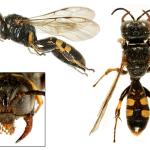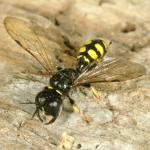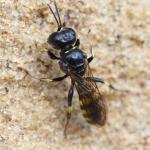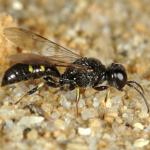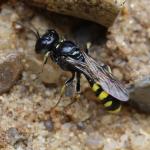Crossocerus bimaculatus LEPELETIER & BRULLÉ,1835; Crabro levipes (VANDER LINDER,1829); Crabro murorum (LATREILLE,1805); Crabro quadripunctatus (FABRICIUS,1793); Crabro quniquemaculatus (DAHLBOM,1838); Crabro rotundarius (DAHLBOM,1838)
Of the several Crossocerus species that nest in the soil, this is the only one with a boldly marked yellow gaster (but beware of specimens without spots). The spine at the bottom of the occipital carina is diagnostic for species recognition.
Widely distributed in Britain as far north as Ayrshire. Also northern, eastern and south-western Ireland and the Channel Islands. Records are concentrated within coastal areas and regions with sandy geology, producing a distinctly patchy distribution that excludes areas like the Cotswolds and much of West Wales. Abroad, found widely in west and south Europe and eastwards through Siberia to Mongolia (Lomholdt 1975-76).
This species is not regarded as being scarce or threatened.
Strongly associated with sandy ground on heathland, in woodland clearings, soft rock cliffs, coastal dunes, quarries and post-industrial sites.
Early May (more typically June) to mid-October. Two generations may occur in southern Britain.
Prey consists of small to medium-sized Diptera, Trichoptera and Lepidoptera (Hamm & Richards, 1926; Maneval, 1939).
Nesting occurs in loose aggregations in sandy ground, often in shady positions as well as sunny ones, e.g. footpaths, sandy banks, around the entrances of rabbit burrows, sandy river banks and the margins of sandy amble land It also nests in the soil around the roots of fallen trees. Often associated with nesting aggregations of other sphecids such as Mimesa equestris, Diodontus tristis, Oxybelus uniglumis and Lindenius albilabris. The larva has been described by Maneval (1939).
Males occasionally visit umbellifers such as wild angelica and hogweed, but they are more often seen sunning on leaves of shrubs (M. Edwards, pers. comm.).
No information available.
2001


